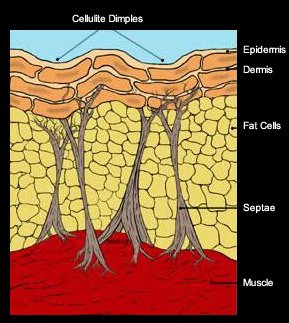| Part 1 | Part 2 |
| Article Summary: |
|
Cellulite is one of the 'dirty' words in the health, fitness or beauty industry; nobody wants it, nobody talks about it and those that do suffer with it are infuriated that not everyone has the same problem.
Why does it appear on some women more than others and why do some men actually get it? This is a fairly recent phenomenon that initially seems to identify with random women and in rarer cases certain men too.1
Nobody likes to talk about it, because nobody really knows what it is and how it is formed, this is due to the research being pretty vague until very recently on what cellulite actually is; the research is just as unclear on what causes it, but finally the very latest studies show us what is really going on and what we can do about it.

Cellulite History 
The first reference to cellulite was not until 1978 by Scherwitz and Braun-Falco2 - their examination of cadavers contained some now known errors on the anatomy of cellulite, but given the lack of peer research at the time, they didn't have a lot to go on, however they did start the research process.
An artist's impression is seen in diagram 1, which contains inaccuracies in its anatomical model which I will explain. The bunching of adipose cells towards the surface is correct in diagram 1, except it isn't septae that pulls the skin down, rather more of a column of adipose cells that pushes up.3 Thus disregard the septae strands and be more aware of certain columns of fat cells becoming loose and free and bulging upward to softer tissues.
Diagram 1 is very typical of current thinking as previous research has been skewed with errors and has offered no good advice to the trainer, fit pro or practitioner.
In regards to errors in research, take Scherwitz & Braun-Falco, their early cadaver studies concluded that skin dimpling was characteristic of women, not cellulite.2 They also concluded men did not get cellulite as the subcutaneous layer of skin is thinner and has a crisscrossing pattern of septae that divide the fat chamber into smaller polygonal units.2
One good piece of information they mentioned was that they found the pinch test is only positive in androgen deficient men. This is a good indicator about what triggers cellulite (hormones) although this was completely overlooked by them and other researchers, until recently.
In 1986, Markman and Barton corrected many of the error's mentioned from Scherwitz and Braun-Falco above and took a step nearer the truth by concluding; cellulite occurs when the deeper layer of the dermis breaks down and the fat is allowed to bulge towards the superficial layer of the skin,4 causing a dimpling effect.
A little more truth was uncovered in 1991, by Lockwood5 when his cadaver and body-contour analysis defined two types of cellulite. These were primary and secondary cellulite.
Primary cellulite was characterized by larger or hypertrophied superficial fat cells. Secondary cellulite was a result of sloppiness in the skin probably caused by sun damage, aging or severe weight loss.5 Similar to Markman and Barton, Lockwood believed the skin layers themselves lost adhesive and failed to keep fat cells from protruding into the dermis.
Lockwood concluded that it was more the superficial layer of the skin that broke down, allowing fat to protrude up and cause the undulations that characterize cellulite, rather than the deeper dermal layer as concluded by Markman and Barton.
These two theories are very close to the truth as it is very specific parts of the dermis that do break down and cellulite dimpling is also caused by the fat cells undergoing hypertrophy3.
Lockwood's model was the best interpretation available, until very recently, however, newer research offers a fresh look at cellulite.
| RELATED POLL | ||
|

The Latest Cellulite Research
Cellulite, sometimes called gynoid lipodystrophy is believed to result when subcutaneous adipose tissue protrudes into the lower reticular dermis, thereby creating irregularities at the surface1.
The irregular, orange peel type dimpled skin surface is characteristic of cellulite and is reported to appear in the thighs, abdomen, and buttocks in 85% of post-adolescent women.4 Cellulite is unrelated to the condition, cellulitis, which is infection of the skin and its underlying connective tissue.
Only two researchers have recently detected the true main culprit for cellulite production - Peter Pugliese and GE Pierard. Cellulite is an interaction of the adipose tissue and connective tissues upon which the sex hormones act3.
Pugliese goes on to say that fat can be considered a sex organ, just as the skin is considered one. This means the hips and thighs are the most common area's of cellulite production due to how this fat is utilized.
Fat on any part of the body is governed by metabolic or hormonal needs, the latter determines if cellulite appears. The hips and thighs are area's more under the control of hormones in women as they are reserved for pregnancy and lactation6. This is why these are the most common sites for cellulite in women and in rarer cases men3.
In fact, cellulite is a natural process in females induced by the hormone estrogen 3,6,7. This hormone's major function is to breakdown the collagen in the cervix at the time of delivery to allow the passage of the baby.

The Process Of Cellulite

Estrogen begins this function at puberty and continues to well after menopause3. This fits in well with Scherwitz & Braun-Falco research as they found the presence of cellulite in an 8-year old child, progressing in severity to a 79-year old great-grandmother.2
It is now known, that women suffer with cellulite due to estrogen and men have little cellulite because they have little estrogen.3 It is interesting to note that collagen breakdown is a biological function of cellulite and this would logically mean that women with excess cellulite are suffering from excess collagen breakdown. The following steps demonstrate the complete cellulite process:
- Step 1: Estrogen acts on fibroblasts.
- Step 2: Fibroblasts act on collagenase.
- Step 3: Collangenase breaks down collagen surrounding fat cells.
- Step 4: Collagen strands deteriorate around packs of fat cells.
- Step 5: Fat cells now spread out toward soft tissue surface of skin.
- Step 6: Loose fat cells also expand and multiply near skin surface to form cellulite appearance.
There are five very important learning outcomes from this discussion thus far:
- Estrogen stimulates the fibroblasts to make collagenase which acts on collagen and breaks it down, which starts the cycle of cellulite formation.
- Collagen is lost in the formation of cellulite.
- Without collagen fibers, fat cells escape out of tightly packed groups and move toward the skin surface and enlarge to their full size (hypertrophy).
- When fat cells reach their full size, they stimulate preadipocytes to develop to form new adipocytes or fat cells.
- Estrogen naturally acts on or stimulates the preadipocytes to form new adipocytes and the more fat you have, the more the ovaries are stimulated to produce estrogen.3
What is now created is a very vicious cycle which begins again, every time the formation of new fat cells or adipocytes is activated, these new fat cells induce greater estrogen levels into the body therefore stimulating the whole process to begin again; this is why cellulite formation can and does get out of control.
So why then are certain women more affected by cellulite and this vicious cycle? It must be that some women control and regulate their estrogen levels more so than other female counterparts.
Lower estrogen levels leads to lower fibroblast activation and a lower or absent cycle of above events. There are reports of some women being completely free from cellulite altogether, for instance Asian and eastern parts of the world display women with little to no cellulite.8

 Click Image To Enlarge.
Click Image To Enlarge.
Some Women Control And Regulate Their Estrogen
Levels More So Than Other Female Counterparts.

Conclusion
It's not surprising cellulite is such a nasty word in the industry, we all know it looks distasteful, but now we also know that if you have cellulite, your fat cells have broken free, started to enlarge and then multiply.
On top of this you have to add that you're hormonally imbalanced and you're collagen levels are low and unless you do something, your body is telling you, it's only going to get worse!
In the second part of this article, we look at how to treat cellulite and discuss what research methods have been used that don't work, as well as show you which dietary regimes and exercise types can more effectively treat cellulite.
Recommended Articles
Bibliography:
- Pierard, GE et al. Cellulite histopathology and related mechanobiology. Int J Cosmet Sci. 2006 Jun:28(3):207-10
- Braun-Falco, O & Scherwitz, C. So called cellulite. J Dermatol Surg Oncolo. 4:230 (1978)
- Pugliese, PT. Physiology of the skin II. Allured Publishing Corp. 2001
- Markman, B & Barton, FE. Anatomy of the subcutaneous tissues of the trunk and lower extremities. Plastic and Reconstructive Surgery, 248 - 254 (Aug 1987)
- Lockwood, TE. Superficial fascia system (sfs) of the trunk and extremities: a new concept. Plastic and Reconstructive Surgery, 1009-1018 (1991)
- Pierard, GE. Commentary on cellulite: skin mechanobiology and the waist-to-hip ratio. J Cosmet Dermatol. 2005 Sep;4(3):151-2
- Pugliese, P. The pathogenesis of cellulite: a new concept. J Cosmet Dermatol. 2007 Jun;6(2):140-2.
- Anecdotal evidence taken from a conversation between Dr. Peter Pugliese and Dr. Bob Bibb. 2008
| Part 1 | Part 2 |
| Share This Article: |






